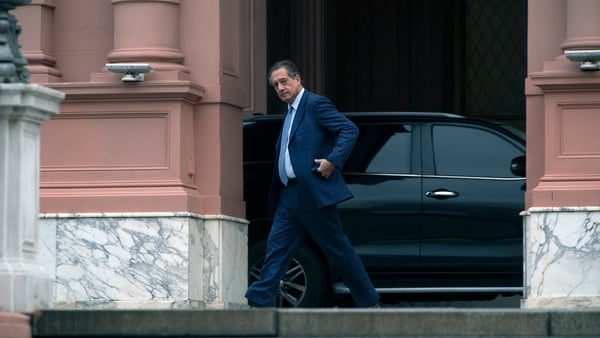Global Courant 2023-04-25 05:24:23
The head of the entity met in the afternoon with Alberto Fernández. On Thursday part of the economic team travels to Washington in an attempt to advance disbursements.
After a new day of tension marked by the frantic rise of the blue dollar to $462 and the greater expectations of devaluation, Miguel Pesce will continue to lead the Central Bank. Sources from the Casa Rosada confirmed his continuity, after the meeting he held this Thursday with the President to analyze the course of the exchange crisis that broke out last week and is still open-ended.
Pesce entered Government House minutes before 4:00 p.m. and left around 6:00 p.m. The official’s presence at Government House triggered rumors about his possible departure from the BCRA amid difficulties in containing alternative prices. With a rise of $20 in the blue, the exchange gap climbed to 110% -the highest since last August-, despite the fact that the Central bought US$105 million in the exchange market.
Pesce’s unexpected visit coincided with the meeting between Alberto Fernández and Foreign Minister Santiago Cafiero with the President of the National Assembly of the Socialist Republic of Vietnam, Vuong Dinh Hue, with whom they discussed bilateral trade and investment. “The President may have seen Pesce five minutes before, I don’t have him, but there was no meeting,” other sources from La Rosada limited themselves to responding.
Pesce is the last of the surviving Albertistas within the economic team, from which Matías Kulfas (Productive Development), Martín Guzmán (Economy) and Mercedes Marcó del Pont were ejected last year. (AFIP). The landing of Sergio Massa did nothing more than limit his margin of action, with measures previously unthinkable or well resisted from the BCRA, such as the dollar for soybeans and foreign tourists.
Urged by the crisis, the minister received Pesce in his office on Thursday. They analyzed the negotiations with the IMF, the rise in rates and the restrictions implemented to stop the outflow of dollars to pay for service imports. The photo was intended to show coordination, after learning about a supposed plan that provided for a 60% devaluation and ended with the abrupt departure of the presidential adviser, Antonio Aracre. But he did not clear the nerves.
The reading in Economy was that Alberto summoned Pesce today because the measures “would not be giving results.” And they ratified the trip to the US this Thursday of the chief adviser, Leonardo Madcur, and the deputy minister, Gabriel Rubinstein. They plan to meet with Treasury officials and the person in charge of Argentina at the IMF, Luis Cubeddu, to review the program and advance disbursements, including funds from the World Bank and the IDB.
The scheme to avoid a sharp devaluation is still in the eye of the storm. The suspension of operations for two business days of access to dollars to import contributed today to the purchase by the BCRA of 100% of the US$ 105 million entered by the soybean dollar. The brake on import demand made it possible to close the second round in a row with a positive balance, including the one on Friday, a fact that reflects the fragility of the situation.
“Probably, tomorrow the retention of dollars will be reduced compared to Friday and today, the key variable is how much of the agricultural dollar can be translated into a real volume, to the extent that there are no genuine purchases, currency settlements have a ceiling and could cut off, marking the beginning of a completely different scenario than now,” warned Salvador Vitelli, economist at Romano Group.
Financial dollars, meanwhile, closed with increases (the CCL, at $462 and the MEP at $449), despite official intervention in the bond market, which moderated them at first. In parallel, the BCRA accelerated the rise of the official dollar to an effective monthly rate of 8.19% compared to Friday, while in the last five rounds it rose to 7.8%. “The frantic rise in the blue market continues, there are no rational measures, there is no calm,” said Andrés Reschini, from F2 Soluciones.
“The electoral calendar increases volatility. Sessions like the ones we are having, I think they are here to stay,” said Paula Gándara, AdCap economist.








